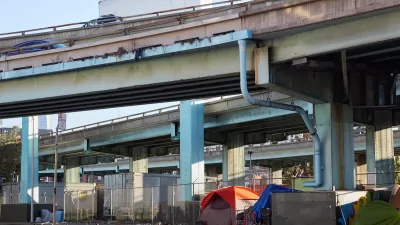In this month's edition of its Planning Advisory Service (PAS) spotlight, the APA looks at the ways in which different communities are addressing homelessness in their comprehensive plans, and through other types of documents.
While the housing element of a comprehensive plan is the logical, and common, place to find policies that seek to address homelessness, the APA notes that many communities are now adopting stand-alone action plans to end the persistent crisis. The APA describes the common approach found in many stand-alone plans, which are gaining in use due to increased federal support, and offer links to a number of relevant examples, from Baltimore to New Orleans and Seattle.
"The most common time horizon for
these stand-alone plans is 10 years," says the APA, "and many plans emphasize a 'housing first' approach, which provides permanent shelter as quickly
as possible. This approach is based on the belief that homeless people
are more likely to overcome their underlying problems if they are
relieved from the stress associated with lack of stable housing. Many of
the plans also focus on prevention with strategies targeted at
ensuring sufficient affordable housing and providing assistance to
people at risk of becoming homeless. With the recent economic downtown
many plans encourage collaboration to ensure efficient use of valuable
resources."
FULL STORY: You Asked. We Answered.

Alabama: Trump Terminates Settlements for Black Communities Harmed By Raw Sewage
Trump deemed the landmark civil rights agreement “illegal DEI and environmental justice policy.”

Planetizen Federal Action Tracker
A weekly monitor of how Trump’s orders and actions are impacting planners and planning in America.

The 120 Year Old Tiny Home Villages That Sheltered San Francisco’s Earthquake Refugees
More than a century ago, San Francisco mobilized to house thousands of residents displaced by the 1906 earthquake. Could their strategy offer a model for the present?

In Both Crashes and Crime, Public Transportation is Far Safer than Driving
Contrary to popular assumptions, public transportation has far lower crash and crime rates than automobile travel. For safer communities, improve and encourage transit travel.

Report: Zoning Reforms Should Complement Nashville’s Ambitious Transit Plan
Without reform, restrictive zoning codes will limit the impact of the city’s planned transit expansion and could exclude some of the residents who depend on transit the most.

Judge Orders Release of Frozen IRA, IIJA Funding
The decision is a victory for environmental groups who charged that freezing funds for critical infrastructure and disaster response programs caused “real and irreparable harm” to communities.
Urban Design for Planners 1: Software Tools
This six-course series explores essential urban design concepts using open source software and equips planners with the tools they need to participate fully in the urban design process.
Planning for Universal Design
Learn the tools for implementing Universal Design in planning regulations.
Clanton & Associates, Inc.
Jessamine County Fiscal Court
Institute for Housing and Urban Development Studies (IHS)
City of Grandview
Harvard GSD Executive Education
Toledo-Lucas County Plan Commissions
Salt Lake City
NYU Wagner Graduate School of Public Service





























